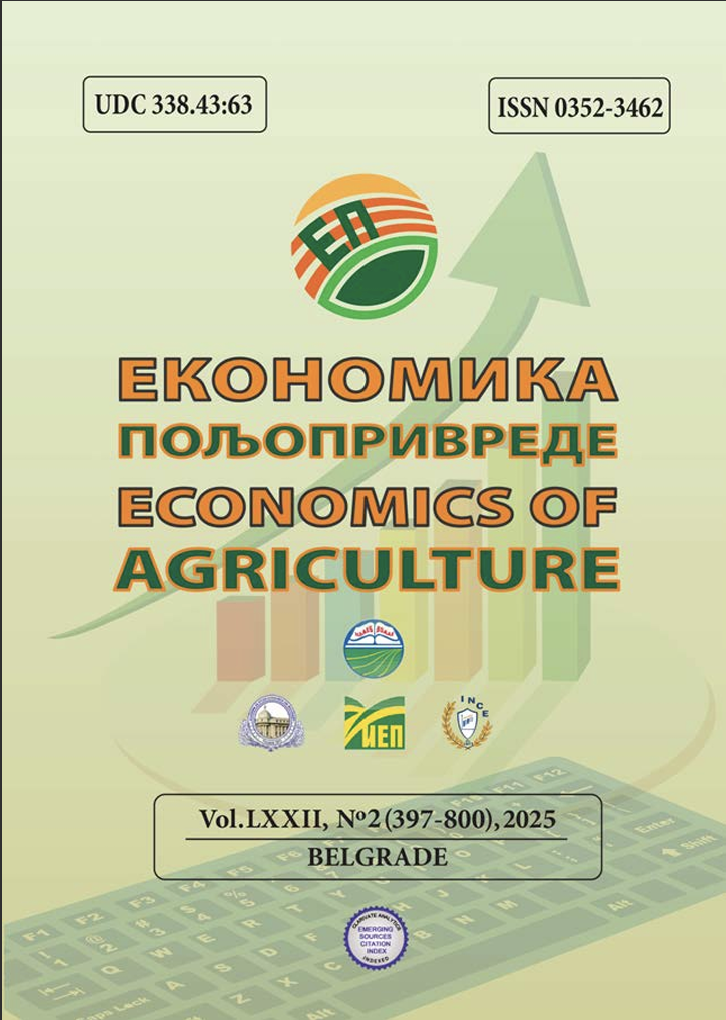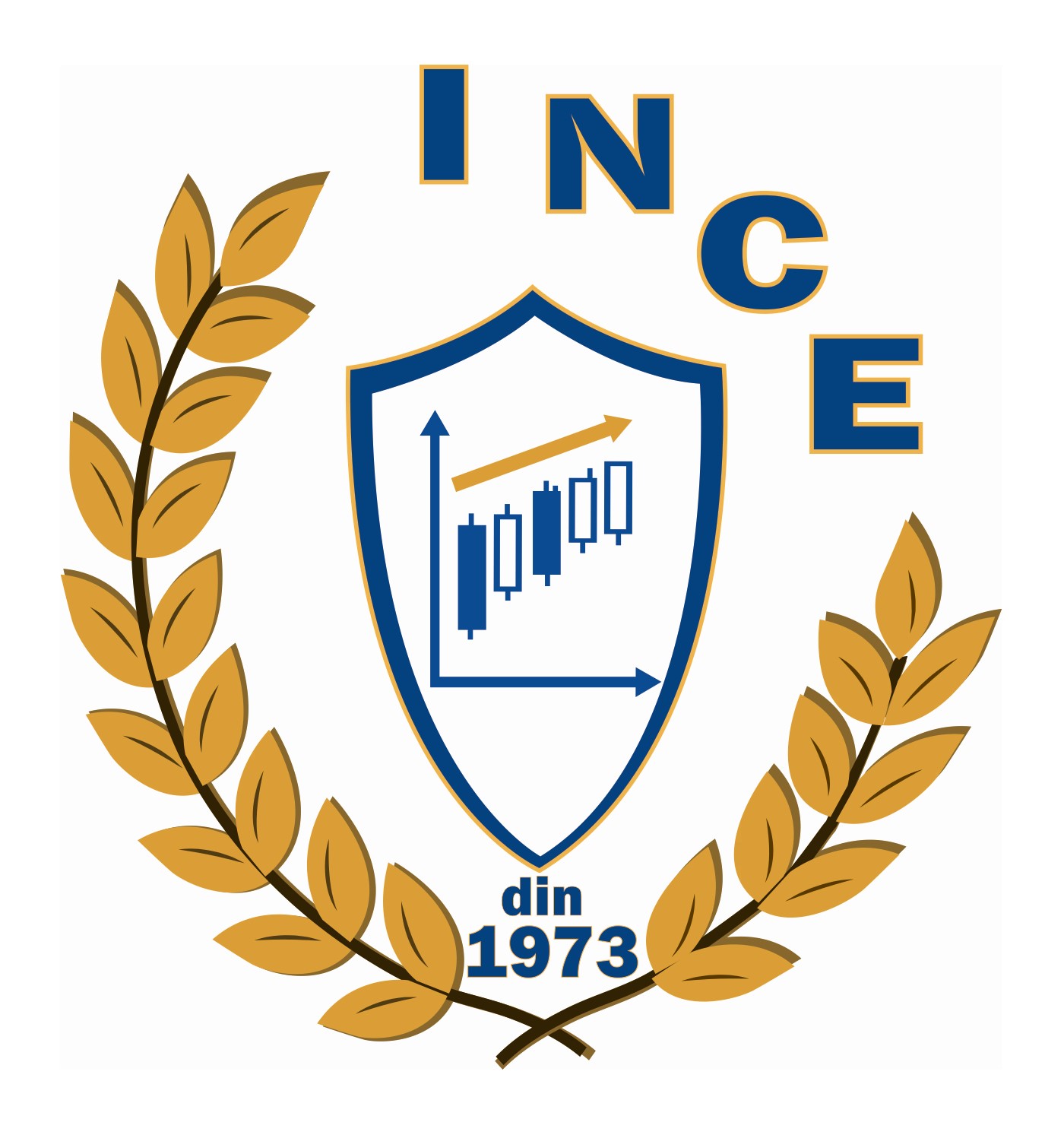ON THE EMPIRICAL DISTRIBUTION OF THE BALASSA AND GRUBEL LLOYD INDEX OF SERBIAN FOOD PRODUCTS
DOI:
https://doi.org/10.59267/ekoPolj2502617IKeywords:
Balassa index, Grubel Lloyd index, food products, SerbiaAbstract
The research analyzes the comparative advantage of Serbia’s agricultural food product exports using the Balassa (RCA) and Grubel-Lloyd (GL) indexes, covering 2005–2024. Results for 2024 show a strong RCA in wheat and a significant advantage in flour, corn, barley, groats, and processed fruit. The greatest RCA growth occurred in barley and spices, while chocolate and dairy products saw the steepest decline. The analysis of trade structure indicates that Serbia maintains a predominantly inter-industry trade pattern across most product groups. However, there is notable growth in intra-industry exchange, as evidenced by an increase in the GL index for tea, live animals, cereal products, and chocolate. The highest GL index growth in inter-industry trade was recorded for processed fish. Overall, the study highlights Serbia’s stable export surplus in agri-food trade and evolving trade dynamics, especially the increasing presence of intra-industry trade in selected product categories.
Downloads
References
Blažková, I., Chmelíková, G. (2015). The Impact of Import Competition on the Development of Market Concentration in the Czech Food and Beverages Industry. In: ICABR 2015: X International Conference on Applied Business Research, Madrid, Spain, Mendel University in Brno, 129-135, Retrieved April 16, 2025 from: https:// spu.fem.uniag.sk/Marian.Toth/publikacie/20152.pdf,
Blažková, I. (2016). Convergence of market concentration: evidence from Czech food processing sectors. AGRIS on-line Papers in Economics and Informatics, 8(4), 25-36.
Bojnec, Š., & Marčeta, M. (2022). Analysis of the economic performance and competitiveness of the European Union countries. Serbian Journal of Management, 17(1), 219-236.
Bojnec, S., Majkovic, D., & Turk, J. (2005). Trade types in Slovenian primary and processed agricultural trade (2005 International Congress, August 23-27, 2005, Copenhagen, Denmark, 24477). European Association of Agricultural Economists.
Czarny, E., Żmuda, M. (2018) Competitiveness as the Ability to Adjust: The EU- 10 Exports Structure and Its Convergence to the German Pattern. Comparative Economic Research, 21(1): 119-133
de Castro, T., Hnát, P. (2017). Czech FDI Performance: Between Global Value Chains and Domestic Reforms. In: Szent-Iványi Balázs [ed.] Foreign Direct Investment in Central and Eastern Europe, Cham: Palgrave Macmillan, 51-75.
Đurić, K; Prodanović, R; Čavlin, M; & Lukač Bulatović, M. (2020). Economic performance of agroindustry in AP Vojvodina. Oditor, 6(2):7-19. doi: 10.5937/Oditor2002007D
Havlik, P., Landesmann, M., & Stehrer, R. (2001). Competitiveness of CEE Industries: Evidence from Foreign Trade Specialization and Quality Indicators. Vienna: The Vienna Institute for International Economic Studies, No. 278
Ignjatijević, S., & Cvijanović, D. (2022). Analysis of Serbian Production and Export of Medicinal and Aromatic Plants. In Research Anthology on Recent Advancements in Ethnopharmacology and Nutraceuticals (pp. 942-960). IGI Global Scientific Publishing.
Ignjatijević, S., Vapa Tankosić, J., Lekić, N., Petrović, D., Brkanlić, S., Vapa, B., Tomašević, V., Puvača, N., Prodanović, R., & Milojević, I. (2022). Agro-Environmental Practices and Business Performance in the Wine Sector. Agriculture, 12(2), 239. https://doi.org/10.3390/agriculture12020239
Ignjatijević, S., Vassileva, A., Vapa Tankosić, J., Vapa, B., Ristić, K., & Mihajlović, M. (2021). Bulgaria’s Processed Food Industry–Transition to Market Economy. Економика пољопривреде, 68(1), 229-240.
Ignjatijević, S., Vassileva, A., Tasić, S., Avakumović, J., & Bešlin Feruh, M. (2020). Izazovi razvoja prehrambene industrije Bugarske u kontekstu evropskih integracija. Ekonomija: teorija i praksa, 13(4), 18-37. https://doi.org/10.5937/etp2004018I
Jaklič, A., Svetličič, M. (2017) Enhanced transition through outward internationalization: outward FDI by Slovenian firms. United Kingdom: Routledge.
Leão, P., & da Silva, M. M. (2021). Impacts of digital transformation on firms’ competitive advantages: A systematic literature review. Strategic Change, 30(5), 421-441.
Majkovič, D., Turk, J., & Chevassus, -Lozza E. (2006) Agri-food Trade Analysis: Comparison of Slovenia with the Nine new Member States. Journal of Central European Agriculture, 7(3): 401-408.
Mizik, T. (2021). Agri-food trade competitiveness: A review of the literature. Sustainability, 13(20), 11235.
Porter, M. (1990) The Competitive Advantage of Nations, New York: The Free Press.
Prodanović, R., Ćirić, M., Ignjatijević, S., Đurić, K., Tankosić, J. V., & Egić, S. (2021). Analysis of factors influencing the competitiveness of domestic honey. Ekonomija-teorija i praksa, 14(4).
Republic Statistical Office (RZS), https://www.stat.gov.rs/
Saboniene, A., Masteikiene, R., & Venckuviene, V. (2013) Lithuania’s export specialization according to technological classification. Mediterranean Journal of Social Sciences, 4(11), 346-351
Smutka, L., Svatoš, M., & Maitah, M. (2017) Czech agrarian foreign trade comparative advantages distribution: Transformation process. In: Asta Raupelienė [ed.] Proceedings of the 8th International Scientific Conference Rural Development 2017, 1312-1317
Svatoš, M., & Smutka, L. (2012). Comparative advantages of the Czech agrarian foreign trade in relation to the EU and third countries. Acta Universitatis Agriculturae et Silviculturae Mendelianae Brunensis, 38(4), 363-378.
Vapa-Tankosić, J., Ignjatijević S., Kranjac M., Lekić S., & Prodanović, R. (2018). Willingness to pay for organic products on the Serbian market. International Food and Agribusiness Management Review, 2 (7), 791–801. https://doi.org/10.22434/IFAMR2017.0068
Vapa-Tankosić, J., Ignjatijević, S., Kiurski, J., Milenković, J., & Milojević, I. (2020). Analysis of consumers’ willingness to pay for organic and local honey in Serbia. Sustainability, 12(11), 4686 4709. https://doi.org/10.3390/su12114686
Downloads
Published
How to Cite
Issue
Section
License
Copyright (c) 2025 Ekonomika poljoprivrede

This work is licensed under a Creative Commons Attribution-ShareAlike 4.0 International License.









